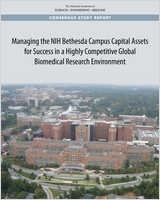From: 6, NIH Current Approach to Strategic Planning for the Bethesda Campus Buildings and Facilities

NCBI Bookshelf. A service of the National Library of Medicine, National Institutes of Health.
The U.S. Department of Agriculture's (USDA's) principal intramural scientific research agency, the Agricultural Research Service (ARS), published its “capital investments strategy” in 2012 at the request of the USDA Secretary in response to Senate and House Reports in fiscal year (FY) 2011 and FY 2012. The Senate Report (111-221) directed the Secretary “to evaluate the agency's capital asset requirements” and House Report (112-101) “directs ARS to establish a long term, multi-year plan to guide capital asset construction decisions for new agricultural research buildings and facilities consistent with program missions, goals, and requirements.”1 The study suggests guidance for future USDA Administration capital budget requests in the short, mid-, and long term, but the primary focus was on identifying appropriate criteria for capital investments in new facilities and infrastructure as well as investments in repair, consolidation, and closure of existing capital assets to avoid unnecessary future investments when funds might not be available and scientific research could be negatively impacted.
Due to the inherent location-specific mission of agricultural scientific endeavor, the study identifies project-specific capital investment recommendations for both the renovation/repair of existing capital assets identified in each of the five ARS Geographic Areas Capital Project & Repair Plans, but also development of new USDA ARS research facilities. The most current USDA ARS capital budget summary of the USDA ARS's prioritization and cost estimates for new building and capital renewal or recapitalization of existing buildings and infrastructure by geographic area was approximately $640 million in FY 2020 costs.2
Table 5 of that publication, “Recommended Out-Year Capital Investments for Modernizing or Replacing ARS Research Facilities” (see Table 6.3.1) was included in the congressional-requested study and resulted in funding for FY 2017 appropriation per the following:
For ARS Buildings and Facilities, the agreement provides an appropriation of $99,600,000 for priorities identified in the USDA ARS Capital Investment Strategy, April 2012, including not less than $5,100,000 for planning and design purposes for the next highest priorities identified in the USDA Capital Investment Strategy.3
U.S. Department of Agriculture, 2012, The USDA Agricultural Research Service Capital Investment Strategy, Washington, D.C.
S. Liu, 2018, “The Agricultural Research Service (ARS) Capital Investment Strategies,” presentation to the committee, August 8.
U.S. Department of Agriculture, 2017, “Division A–Agriculture, Rural Development, Food and Drug Administration, and Related Agencies Appropriations Act, 2019,” Appropriations Explanation Statement, https://nifa
Recommended Out-Year Capital Investments for Modernizing or Replacing Agricultural Research Service (ARS) Research Facilities.
From: 6, NIH Current Approach to Strategic Planning for the Bethesda Campus Buildings and Facilities

NCBI Bookshelf. A service of the National Library of Medicine, National Institutes of Health.